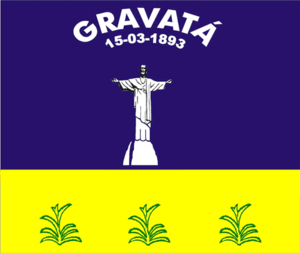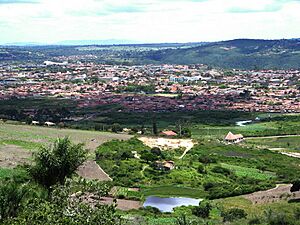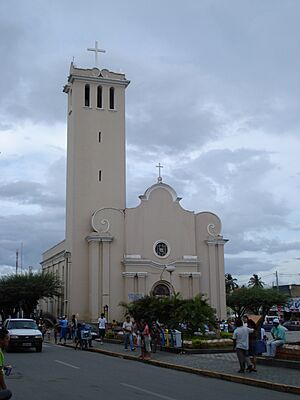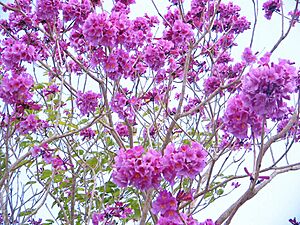Gravatá facts for kids
Gravatá is a lively city in the state of Pernambuco, Brazil. It's about 75 km (47 mi) from Recife, the capital city of Pernambuco. In 2020, about 84,699 people lived in Gravatá.
Contents
Gravatá's Location and Climate
Gravatá is located at 08°12′04″S 35°33′53″W. It sits at an average height of 447 meters (1,467 ft) above sea level. The city covers an area of 491.53 km² (189.78 sq mi). Gravatá is famous for its cool and pleasant weather, with an average yearly temperature of 18°C (64°F). You'll also see charming houses that look a bit like those in the Alps mountains!
The city is in a rural area of Pernambuco called Agreste Pernambucano. It's in the Ipojuca Valley, which is a special area where forests meet the countryside. This region was once known as the Borborema Plateau. Today, it's called Serra das Russas, which means "Russians' Mountain." This name comes from some people with blonde and red hair who live there, descendants of Dutch settlers. People in this part of Brazil used to call them "Russians." Gravatá is also part of the Capibaribe River basin.
Gravatá is an important city in the region. It's connected to Recife by a main highway, BR-232, which also passes through Vitória de Santo Antão and Jaboatão dos Guararapes.
The plants you'll find in Gravatá include savannahs (grassy plains), natural pastures, swamps, sandbanks, and forests.
For local government, Gravatá includes its main city area and smaller towns like Uruçu-Mirim, Russinhas, São Severino de Gravatá, Avencas, and Ilha Energética.
Gravatá's History
Gravatá started as a farm in 1808. This farm belonged to José Justino Carreiro de Miranda. It was a resting place for travelers and sold sugar and beef. Back then, traveling from Recife into the country along the Ipojuca River was hard. Merchants had to stop often to keep their cattle healthy. One of these stops was called "Crauatá." This name came from the Tupi language word "Karawata," which means "piercing bush." It referred to a plant like a bromeliad, also known as Caraguatá or Gravatá, that grew a lot in the area.
In the late 1700s, José Justino Carreiro de Miranda took over the Gravatá Farm. It served as a lodging for travelers for a long time. Soon, small communities grew on both sides of the river. In 1810, they started building the Sant'Ana chapel. It was finished 12 years later by João Félix Justiniano, José Justino's son.
After that, the land was divided into 100 plots and sold to people. This helped the town of Gravatá grow. At first, it was part of the Bezerros municipality. In 1875, it became its own parish. Then, on May 30, 1881, Gravatá officially became a town (municipio) by a special law. The old chapel became the main church. On June 13, 1884, the town was made a city. However, Gravatá truly gained its own independence after Brazil became a republic. On March 15, 1893, the city's government became self-governing, and Antonio Avelino do Rêgo Barros was elected as its first mayor.
In the late 1800s, the Great Western Railway opened. This railway connected Recife to the inner parts of Pernambuco. This helped Gravatá grow a lot. The city slowly became known as a great place for tourism, especially after the BR-232 road was built through the "Mountains of Russians."
The Great Western Railway
The railway line between Recife and Gravatá was built from 1881 to 1894. Building it was a big challenge because of the mountains around Gravatá. Many bridges and tunnels were needed. For example, the Grota Funda bridge is 180 meters (591 ft) long and 48 meters (157 ft) high! From 1945 to 1947, the railway was updated. Iron bridges were replaced with stronger concrete ones. In 1986, the railway was recognized for the amazing views along its route.
This railway was very important for the development of Pernambuco's interior. It made it possible to move goods and people quickly and in large amounts. This led to an economic boost in the region, helping trade and tourism grow.
Tourism in Gravatá
Gravatá has about 75,000 residents, but on weekends, its population can jump to around 130,000 people! Many tourists come to enjoy the city's cool and pleasant climate. Throughout the year, Gravatá hosts several events that attract more and more visitors.
- In January, on the second Sunday, they celebrate the traditional Festa de Reis (Kings' Festival).
- In February, there are pre-Carnival street parties.
- During Easter Week in April, Gravatá becomes one of the biggest celebration spots in the state. It's part of the Passion Itinerary. Local actors perform plays about Christ's Passion, and there are big music shows. About 300,000 people visit Gravatá during this time.
- In May, religious tourism takes center stage with Frei Damião's Festivities. A large walk goes from the Nossa Senhora de Sant'Ana church to the Capela do Riacho do Mel (chapel of the river of honey). This is where Frei Damião celebrated his first mass in Brazil.
- In June, the São João (Saint John) festival takes place. Even though it only started in 2002, it's already one of the biggest and best in the country. In the first half of the month, the "Community São João" happens. This is a parade that leaves downtown every night, going to a different neighborhood or district. It has flags, balloons, music, and lots of free traditional food. In the second half of the month, at the fairground, which is decorated with flags and balloons, there are dance contests and shows by national artists, plus local and regional acts. During this period, the number of visitors to the city reaches 500,000 people!
- In the first week of August, the Feira da Estação (Station Fair) happens. This is part of the "Circuit the Cold," an event organized by the State Government. It brings workshops and cultural and musical performances to cities in Pernambuco.
- In September, different businesses (furniture, crafts, food, flowers, and strawberries) organize the Cultural Festival.
- In December, the main streets and squares of the city are beautifully decorated with special lights for "Paz's Christmas" (Christmas of Peace). Artists of all kinds, like dance academies, choirs, theater groups, and bands, perform in the central areas.
Gravatá's Economy
Gravatá's main economic activities are farming, retail trade, and raising animals. In farming, they grow pineapples, corn, cotton, sweet potatoes, tomatoes, tangerines, beans, bananas, cassava, and strawberries.
In retail, you'll find "artesanato," which are handmade crafts for homes and gardens, as well as accessories. It's said that some of the most beautiful costume jewelry, made from crystals and semi-precious stones, comes from Gravatá.
Gravatá is an important producer of vegetables in rural Pernambuco. It produces and sells about 2 tons of vegetables each week at local fairs and in nearby cities like Caruaru and Recife. Growing plants and flowers is another important part of the economy. Gravatá grows many types of roses, chrysanthemums, and other flowers. It's the city with the largest production of temperate flowers in the Northeast of Brazil!
Another important activity is making rustic furniture from solid wood, wicker, and rattan. There are also many artisans in Gravatá who create various crafts.
In the animal breeding sector, Gravatá is known for its excellent selected breeds. They raise horses, cattle, sheep, and goats. There are also many dog breeders, including breeds like Rottweiler, Boxer, and Cocker Spaniel.
Housing Market
The housing market in Gravatá is one of the most important in Pernambuco's interior. This is because of the improved BR-232 highway (now called Rodovia Luiz Gonzaga) and the many land plots and rural communities being built. Real estate agents say that Gravatá has the most expensive land per square meter in the state. It's also where the most houses are built in Pernambuco, with an average of five new houses built every day!
Gravatá's Landmarks
- Alto do Cruzeiro: This is where you'll find the statue of Christ the Redeemer (Cristo Redentor). You can reach it by climbing the 365 steps of the "Escadaria da Felicidade" (Staircase of Happiness). It's a great spot for food and to watch the sunset.
- Pole Moveleiro: This is a marketplace where you can buy rustic furniture made from solid wood.
- Estação do Artesão (Artist's Station): Located in the old railway station, right next to the Patio de Eventos Chucre Mussa Zarzar fairground. Here, local artisans sell their beautiful artworks.
- Memorial da Cidade (City Memorial): This museum is located in the old public jail building.
- Banho de Dona Nadir (Dona Nadir's Bath): About 12 km (7.5 mi) from the city, this place has natural swimming pools.
- Architecture: Gravatá has many charming old buildings from past centuries. These include the City Hall (built in 1908), the Igreja Matriz de Santa'Ana church (built in 1810), the houses along the avenue, and the Chapel the Cruise. These buildings give the city a special charm.
See also
 In Spanish: Gravatá para niños
In Spanish: Gravatá para niños





